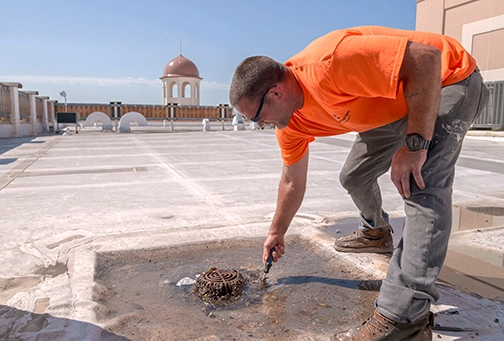Early Signs of Commercial Roof Issues & The Importance of a Roofing Maintenance Plan
What do warehouses, manufacturing facilities, large office buildings, schools, and entertainment venues all have in common? They are all large facilities that could consist of multiple buildings that are very large in size, even as much as a few acres! If you work in one of these facilities or in any type of commercial building, you see the buildings on your campus each day, but are you aware of the issues specific to your commercial building roof type? Each building could have a different type of commercial roof, and each roof is very important.

A roof is one of the most essential components of a structure. If a commercial roof is not maintained properly, it could result in a costly emergency roofing repair. Why? Because not all roof damage is detectable by sight. If you are not being proactive about looking for problems before they start, you could end up having a roofing emergency.
To prevent a small roofing problem from turning into a large one, facilities should have a regular commercial roof maintenance plan that is utilized a few times a year. This will ensure the safety, efficiency, and correction operation of the industrial roof types on the property. This maintenance plan should include the following six steps to help identify roofing issues before they become problems.
1. Conduct a Visual Inspection
A facility could have a roofing issue that isn’t visible from the ground. As such, a thorough onsite inspection of all the roof surfaces should be performed regularly. An inspector should climb up on top of the roof and look for any signs of damage, such as cracks, blistering, loose, or missing shingles, rusted metal panels, or damaged flashing. The inspector should also pay special attention to areas around vents, chimneys, skylights, and other roof penetration areas. If these items are not sealed or are falling apart, the integrity of the roof and the facility could be in jeopardy.
In addition to the roofing structure itself, it’s also important to scan for surrounding vegetation and debris that could be having a negative impact on the roof. Plants, such as moss or algae, can indicate excessive moisture on a roof surface, indicating underlying water damage or a mold problem. Debris, such as leaves or branches, should also be removed since these items can clog drains and cause water to back up.
2. Check for Leaks and Water Stains
Just as the outside of a roof should be regularly inspected, so should the underside. Conducting a visual indoor inspection of your buildings’ interior ceilings and walls for any signs of water leaks or stains is essential. Water stains can indicate a commercial roof leak, where water is coming in from the outside and seeping into the building.
3. Ensure Proper Drainage
The gutters, downspouts, and other drainage systems on a roof are crucial for channeling water away from the structure. Without them, a building will experience poor drainage, which can lead to water pooling and causing severe damage. To prevent this from happening, gutters, downspouts and any other exterior drainage systems should be inspected to ensure they are clear of debris, draining away from the building, and functioning properly.
4. Inspect the Roof Membrane
A roof membrane is a roofing system that is used on flat and low-sloped roofs. Roofing membranes are often thin, single layers of material, but thicker, built-up roofs can also fall into this category. Roofing membranes are common on roofs used in commercial spaces. If your facility’s roof has a membrane system, such as an EPDM coating, TPO roof coating, or PVC, it needs to be inspected routinely for cuts, tears, or punctures. It is also important to look for any areas of the roof where the membrane may be lifting or coming loose. If these areas are not addressed, water can leak into your commercial space.
5. Check Flashing and Sealants
Flashing and sealants help prevent water infiltration by providing a waterproof seal for many types of roofs, including metal building roof coatings, tile, and asphalt. As a result, the flashing around roof penetrations and edges should be routinely inspected. It’s important to check for signs of deterioration or damage, which could indicate serious problems. Sealants or caulking around vents, skylights, or other roof components should also be checked to ensure they remain intact and are in good condition. Flashing and sealants that are not functioning properly will allow water to enter a building.
6. Ensure the Roof’s Structural Integrity
With time, everything ages and even sturdy metal and concrete commercial buildings can deteriorate. That’s why it’s important to assess the overall structural integrity of a roof by conducting a commercial roof assessment. It’s important to look for signs of sagging, unevenness, or deflection. Any of these issues could indicate an underlying structural problem that needs to be addressed promptly.
When conducting a roof inspection, safety should be the top priority. The roof inspector should use appropriate personal protective equipment and consider using safety harnesses. If your facility does not have these safety measures, your roof is difficult to access, or the roof inspection requires specialized skills, you should hire a professional roofing contractor to assist you.
If a commercial roofing maintenance plan has been put into place and these six steps are followed a few times a year, your facility should not have any issues with its commercial roofs. A properly functioning roof helps to ensure year-round energy efficiency and a comfortable working environment. A leaking or damaged roof can disrupt a business’s activities, impede productivity, and impact profitability.
If any issues or concerns are noted during your roofing inspections or if you do not have a commercial roof maintenance plan or someone on staff who can perform regular roof inspections, contact us to discuss service plans to ensure your buildings’ roofs are kept in the best condition possible for as long as possible.